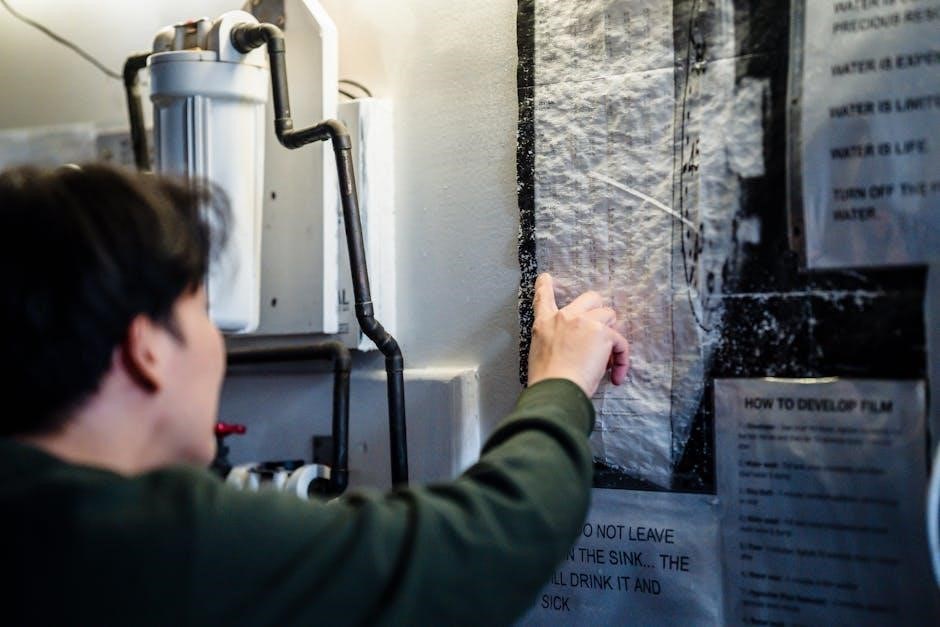Tanker Endorsement Study Guide PDF: A Comprehensive Overview
Seeking a comprehensive guide to ace your tanker endorsement exam? Look no further! Our study guide will provide valuable insights.
This guide covers key topics, including regulations, safety procedures, and vehicle inspections, offering a structured approach to mastering the knowledge required for successful certification.
Prepare effectively with our user-friendly PDF!
What is a Tanker Endorsement?
A tanker endorsement, often called an “N” endorsement, is a special certification added to a Commercial Driver’s License (CDL). It shows that a driver is qualified to transport liquids or gases in bulk.
This endorsement is essential for drivers operating tank vehicles with a capacity of 1,000 gallons or more; It signifies that the driver possesses the necessary knowledge and skills to safely handle the unique challenges associated with hauling liquid or gaseous cargo.

The training required to obtain a tanker endorsement is extensive, ensuring drivers are well-prepared to manage the inherent risks of transporting these materials. This includes understanding surge control, performing thorough pre-trip inspections for leaks, and adhering to specific load requirements based on the substance being transported.
Without this endorsement, drivers are prohibited from legally transporting large quantities of liquids or gases. It is a mandatory requirement to broaden job opportunities for truckers, especially those seeking to drive commercial vehicles carrying liquid cargo. The endorsement demonstrates additional safety skills.
It’s not just about hauling any liquid; the endorsement applies when transporting bulk quantities in tanks, not individually packaged items like bottles of water, even if the total volume exceeds 1,000 gallons.
When is a Tanker Endorsement Required?
A tanker endorsement is required when transporting liquids or gases in bulk, specifically in tanks or combinations of tanks with a total capacity of 1,000 gallons or more. This applies to scenarios where individual containers exceed 119 gallons in capacity.
Consider this: if you’re hauling a single tank containing 500 gallons of liquid and another tank containing 600 gallons, a tanker endorsement is mandatory because the combined capacity surpasses the 1,000-gallon threshold.
It’s important to note that the endorsement isn’t merely about the total volume being transported. It’s about the individual or combined capacity of the tanks themselves. For instance, hauling multiple smaller containers that individually hold less than 119 gallons, even if the total volume exceeds 1,000 gallons, typically doesn’t require a tanker endorsement.

The key is the presence of large-capacity tanks designed for bulk transport of liquids or gases. This requirement ensures that drivers operating these specialized vehicles have the necessary training and knowledge to handle the unique challenges associated with transporting such loads, including managing liquid surge and maintaining vehicle stability.

Failing to obtain the required tanker endorsement when necessary can result in significant penalties, including fines of up to $5,000 per instance.
CDL Tanker Endorsement Requirements

To obtain a CDL Tanker Endorsement, several key requirements must be met. Firstly, the applicant must possess a valid Commercial Driver’s License (CDL), specifically a Class A or Class B license. This is a prerequisite, as the tanker endorsement is an addition to an existing CDL, signifying the driver’s qualification to operate specialized vehicles.
Age is also a factor; applicants must be at least 18 years old, or 21 for interstate driving. Furthermore, a critical aspect of the application process involves passing a written knowledge test focused specifically on tanker vehicle operations. This test assesses the applicant’s understanding of crucial safety measures, proper pre-trip inspection procedures for leaks, and techniques to manage liquid surge effectively.
In addition to the written test, drivers must demonstrate knowledge of load requirements. Different liquids have varying carrying limits due to expansion properties.
While a driving skills test is not typically required for the tanker endorsement itself, a solid understanding of safe driving practices with tanker vehicles is paramount. Meeting these requirements ensures that drivers operating tanker vehicles possess the necessary skills and knowledge to transport liquid and gas cargo safely.
You must also have a valid U.S. passport or valid residential status.
Age and License Type Requirements
Securing a tanker endorsement for your Commercial Driver’s License (CDL) involves specific age and license prerequisites. The minimum age requirement typically stands at 18 years for intrastate operations, meaning driving within state boundaries. However, for interstate operations, which involve crossing state lines, the age threshold increases to 21 years. This higher age requirement reflects the added responsibility and complexity associated with long-haul transportation.
In addition to age, the type of CDL held is crucial. A tanker endorsement can only be added to either a Class A or Class B CDL. A Class A CDL permits the operation of any combination of vehicles with a gross combination weight rating (GCWR) of 26,001 pounds or more, provided the gross vehicle weight rating (GVWR) of the vehicle being towed is in excess of 10,000 pounds. A Class B CDL, on the other hand, allows the operation of a single vehicle with a GVWR of 26,001 pounds or more, or any such vehicle towing another not in excess of 10,000 pounds.
It’s important to note that a Class C CDL, which typically covers smaller vehicles, cannot be used to obtain a tanker endorsement.
Ensure your license aligns with these requirements.
Testing Requirements for Tanker Endorsement
Acquiring a tanker endorsement demands successfully completing a knowledge test designed to assess your understanding of the specific safety considerations involved in transporting liquids or gases in bulk. This written examination evaluates your grasp of crucial concepts related to tanker vehicle operation, including cargo loading and unloading procedures, vehicle inspection protocols, and safe driving techniques tailored to the unique challenges posed by liquid cargo.
The tanker endorsement test typically consists of 20 multiple-choice questions, and a passing score generally requires answering at least 80% of the questions correctly. The test covers a range of topics, such as understanding the effects of liquid surge, managing load distribution, and identifying potential hazards associated with different types of liquids and gases.
Prior to taking the test, thorough preparation is essential. Reviewing the official CDL manual, specifically the section dedicated to tanker vehicles, is highly recommended. Practice tests can also be valuable in familiarizing yourself with the format and content of the actual exam. Remember, understanding the principles behind safe tanker operation is as important as memorizing facts. Aim for a comprehensive understanding to ensure you’re well-prepared to pass the test and operate a tanker vehicle safely and responsibly.
Hazardous Material Endorsement (HME)
The Hazardous Materials Endorsement (HME) is a critical addition to a Commercial Driver’s License (CDL) for drivers who transport hazardous materials. Obtaining an HME involves a more rigorous process than a standard tanker endorsement, as it necessitates a thorough background check by the Transportation Security Administration (TSA) to ensure national security. This background check includes fingerprinting and a review of your criminal history.
To qualify for an HME, you must be at least 21 years old and possess a valid CDL. In addition to passing the standard CDL knowledge tests, you must also pass a separate hazardous materials knowledge test. This test covers topics such as hazard classes, placarding requirements, emergency response procedures, and hazardous material handling regulations.
Furthermore, HME holders are subject to ongoing security threat assessments; This means that your background may be rechecked periodically to ensure you continue to meet the security requirements. An HME combined with a tanker endorsement (often referred to as an “X” endorsement) allows drivers to transport hazardous liquids or gases in bulk. If you plan to haul hazardous materials in a tanker, obtaining both endorsements is essential for compliance with federal regulations and safe operation.
What Does a Tanker Endorsement Allow You to Do?
A tanker endorsement on your Commercial Driver’s License (CDL) significantly expands your career opportunities as a professional truck driver. This endorsement grants you the legal authority to operate commercial vehicles designed to transport liquids or gases in bulk, typically in tanks with a capacity of 1,000 gallons or more. This opens doors to a wide range of specialized hauling jobs that are not available to drivers without this endorsement.
With a tanker endorsement, you can transport various commodities, including gasoline, milk, water, liquid chemicals, and other fluids essential to industries and communities. These jobs often involve higher pay rates due to the specialized skills and knowledge required to safely handle and transport these materials. Tanker drivers must be proficient in managing the unique challenges associated with liquid cargo, such as liquid surge, which can affect vehicle stability.
Moreover, a tanker endorsement demonstrates a commitment to safety and professionalism, making you a more attractive candidate to potential employers. It signifies that you have undergone the necessary training and testing to operate a tanker vehicle competently and responsibly, ensuring the safe delivery of essential goods while adhering to all applicable regulations.
What Happens If You Don’t Obtain the Tanker Endorsement?
Operating a commercial vehicle hauling liquids or gases in bulk without the required tanker endorsement can lead to serious consequences, both legally and professionally. If you are caught driving a tanker vehicle with a capacity of 1,000 gallons or more without the proper endorsement on your Commercial Driver’s License (CDL), you will face significant penalties.
These penalties can include hefty fines, which may reach up to $5,000 per instance. Furthermore, you may face disqualification from operating a commercial motor vehicle, impacting your ability to earn a living as a truck driver. Your employer may also face penalties for allowing you to operate the vehicle without the necessary endorsement.
Beyond the legal ramifications, operating without a tanker endorsement poses significant safety risks. Tanker vehicles require specialized knowledge and skills to handle the unique challenges of liquid surge and maintain vehicle stability. Without proper training, you are more likely to be involved in an accident, potentially causing serious damage, injury, or even fatalities.
Therefore, it is crucial to obtain the tanker endorsement if you intend to haul liquids or gases in bulk. This ensures that you have the necessary skills and knowledge to operate a tanker vehicle safely and legally, protecting yourself, other drivers, and the environment.
Tanker vs. Hazmat Endorsements
While both tanker and Hazmat endorsements relate to transporting specific types of cargo, they serve distinct purposes and have different requirements. A tanker endorsement (typically the “N” endorsement) is required for drivers who operate vehicles transporting liquids or gases in bulk, generally in tanks with a capacity of 1,000 gallons or more. This endorsement focuses on the unique handling characteristics of liquids and gases, such as liquid surge, and ensures drivers are trained to manage these challenges.
On the other hand, a Hazmat endorsement (typically the “H” or “X” endorsement) is required for drivers who transport hazardous materials, as defined by the Department of Transportation (DOT). Hazardous materials include substances that pose a risk to health, safety, or property during transportation; This endorsement requires a more extensive background check, including fingerprinting and a security threat assessment by the Transportation Security Administration (TSA).
The key difference lies in the cargo being transported. The tanker endorsement is based on the type of vehicle (a tank) and the substance being liquid or gas, regardless of whether it is hazardous. The Hazmat endorsement is based on the inherent hazard of the material, regardless of the type of vehicle used for transport. It’s important to note that some loads may require both endorsements if you are transporting hazardous liquids or gases in bulk.
Where to Find Study Materials
Preparing for the tanker endorsement exam requires access to reliable and comprehensive study materials. Fortunately, there are several resources available to help you succeed. Your primary source should be your state’s Commercial Driver’s License (CDL) manual. This manual contains detailed information about tanker vehicle operation, safety regulations, and the specific knowledge required for the endorsement. Look for the sections specifically related to tanker vehicles and hazardous materials, if applicable.
In addition to the CDL manual, consider utilizing online resources. Many websites offer practice tests and study guides specifically designed for the tanker endorsement. These practice tests can help you assess your understanding of the material and identify areas where you need further review. Search for reputable websites that provide accurate and up-to-date information.
Furthermore, consider enrolling in a CDL training course. These courses often include comprehensive instruction on tanker vehicle operation and provide valuable hands-on experience. Instructors can answer your questions and provide personalized guidance to help you prepare for the exam. Finally, don’t overlook the value of studying with others. Forming a study group with fellow CDL students can provide a supportive learning environment and allow you to share knowledge and insights. Remember to verify the accuracy of any information you obtain from unofficial sources.
